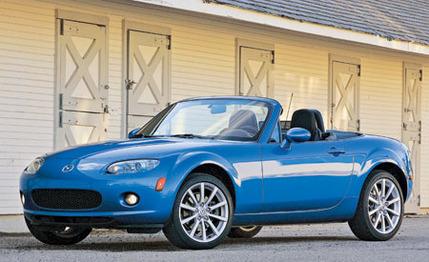
 Short Take Road Test
Short Take Road Test
When the third-generation MX-5 arrived last fall, we fell in love with Mazda's roadster all over again. Even though the MX-5 now has a bigger, more powerful engine and a much stiffer chassis, it stayed true to its lightweight, fun-to-drive roots. In our December 2005 issue we put it up against the Pontiac Solstice, and it prevailed. The following month it made our 10Best Cars list for the seventh time since the original Miata made us all weak in the knees in 1989. But in more than 30 articles we've penned about this little roadster since its introduction, we'd never tested one with the optional four-speed automatic. After all, isn't it heresy to put a slushbox in a British-style sports car?
For 2006, Mazda offers a new automatic transmission in the MX-5, with six speeds and manumatic shifting via paddles mounted on the steering wheel. This, we thought, was worth a look.
Like most manumatic automatics, the MX-5's new six-speed has two modes: drive and manual. In the latter, you shift gears with the lever - pull back to go up a ratio, push forward to go down - or the two paddles, which are upshifted by flicking the bottom half and downshifted by tapping the top portion. What could be simpler? Mazda didn't ask, but we prefer the traditional Formula 1-style method of upshifting with a paddle on the right and downshifting with a counterpart on the left, but you quickly get used to the MX-5's layout.
We like that this transmission will not upshift automatically, no matter how often you bounce off the rev limiter. It's in keeping with the truly manual character you'd expect in a sports car, even though this tranny is in fact an automatic. It will downshift on its own, however. Shifts are quick and smooth, although they feel a bit snappier when you're using the paddles. Our testing backs this up, as the paddle shifter shaved a couple 10ths off the 0-to-60-mph and quarter-mile times.
Mazda also did a great job tuning the torque converter. It's easy to get a strong launch from a standstill by using a little brake torque. As a result, the automatic's acceleration times are relatively close to those of the six-speed manual MX-5 we tested in the October 2005 issue. That car took 6.5 seconds to reach 60 mph and turned the quarter-mile in 15.0 seconds at 91 mph. The automatic takes 7.0 and 15.6 seconds at 89 mph. The only real difference between the manual and the automatic comes at triple-digit speeds, as our manual test car reached a respectable 131 mph, 11 mph faster than the automatic.
Sometimes, an automatic chokes the life out of a sports car, but this MX-5's dynamics are every bit as playful as its manual counterpart's. At 2512 pounds, the automatic is only 30 pounds heavier than the manual we tested in October, and it still maintains good weight balance, with 52.5 percent on the front tires. This MX-5 auto feels as neutral, nimble, and responsive as the manual. In fact, it even pimped the manual around the skidpad, maintaining 0.91 g of grip instead of 0.90. That's even more impressive when you consider that this car didn't have the Bilstein shocks and limited-slip diff that make up the optional suspension package that's only available with the six-speed manual.
You'll pay $1100 for the automatic, and it's available on the Touring, Sport, and Grand Touring models. Our tester was a Sport that included the larger 17-inch wheels, bringing the as-tested price to $24,595. Mazda predicts that 20 percent of the roughly 2000 MX-5s sold every month will be automatics, which is about the same spread recorded by the second-generation model between 1999 and 2005. We think the company will have no problem doing so, considering that you're not giving up much performance.